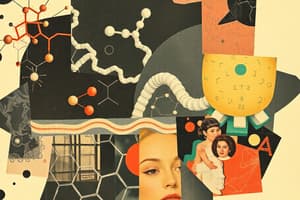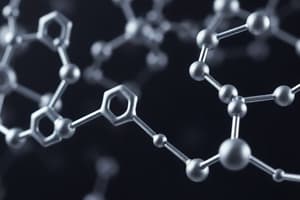Podcast
Questions and Answers
What role do proteins play in muscle function?
What role do proteins play in muscle function?
- They provide movements through contractile functions. (correct)
- They serve as hormones for muscle growth.
- They primarily act as transporters within the body.
- They act as structural components solely.
Which type of protein consists only of amino acid residues?
Which type of protein consists only of amino acid residues?
- Structural proteins
- Simple proteins (correct)
- Derived proteins
- Conjugated proteins
What is the primary function of immunoglobulins in the body?
What is the primary function of immunoglobulins in the body?
- Act as enzymes for metabolic reactions.
- Serve as a first line of defense against infections. (correct)
- Store nutrients like iron.
- Transport substances across cell membranes.
What distinguishes conjugated proteins from simple proteins?
What distinguishes conjugated proteins from simple proteins?
Under what condition can proteins be used for energy production?
Under what condition can proteins be used for energy production?
What stabilizes the quaternary structure of proteins?
What stabilizes the quaternary structure of proteins?
Which of the following correctly describes a homotetramer?
Which of the following correctly describes a homotetramer?
Which characteristic of denaturation indicates that the primary structure remains unchanged?
Which characteristic of denaturation indicates that the primary structure remains unchanged?
What is often a consequence of protein denaturation when proteins are cooked?
What is often a consequence of protein denaturation when proteins are cooked?
In the context of protein denaturation, which process can be reversed under certain conditions?
In the context of protein denaturation, which process can be reversed under certain conditions?
Flashcards
Proteins
Proteins
Nitrogenous macromolecules composed of amino acids.
Cytoskeleton
Cytoskeleton
A framework of proteins that provides structural support to cells.
Enzymes
Enzymes
Biological catalysts made of proteins.
Immunoglobulins
Immunoglobulins
Signup and view all the flashcards
Hormones
Hormones
Signup and view all the flashcards
Structural Proteins
Structural Proteins
Signup and view all the flashcards
Contractile Proteins
Contractile Proteins
Signup and view all the flashcards
Receptors (proteins)
Receptors (proteins)
Signup and view all the flashcards
Transport Proteins
Transport Proteins
Signup and view all the flashcards
Storage Proteins
Storage Proteins
Signup and view all the flashcards
Respiratory Pigments
Respiratory Pigments
Signup and view all the flashcards
Simple Proteins
Simple Proteins
Signup and view all the flashcards
Conjugated Proteins
Conjugated Proteins
Signup and view all the flashcards
Derived Proteins
Derived Proteins
Signup and view all the flashcards
Interaction between Lysine and Aspartate
Interaction between Lysine and Aspartate
Signup and view all the flashcards
Quaternary Structure
Quaternary Structure
Signup and view all the flashcards
Protein Subunits
Protein Subunits
Signup and view all the flashcards
Multimers
Multimers
Signup and view all the flashcards
Homotetramer
Homotetramer
Signup and view all the flashcards
Heterotetramer
Heterotetramer
Signup and view all the flashcards
Denaturation
Denaturation
Signup and view all the flashcards
Characteristics of Denaturation (1)
Characteristics of Denaturation (1)
Signup and view all the flashcards
Characteristics of Denaturation (2)
Characteristics of Denaturation (2)
Signup and view all the flashcards
Characteristics of Denaturation (3)
Characteristics of Denaturation (3)
Signup and view all the flashcards
Characteristics of Denaturation (4)
Characteristics of Denaturation (4)
Signup and view all the flashcards
Characteristics of Denaturation (5)
Characteristics of Denaturation (5)
Signup and view all the flashcards
Characteristics of Denaturation (6)
Characteristics of Denaturation (6)
Signup and view all the flashcards
Characteristics of Denaturation (7)
Characteristics of Denaturation (7)
Signup and view all the flashcards
Study Notes
Protein Chemistry (Part 1)
- Objectives for this lecture include: amino acid structure and importance, amino acid classification, and amino acid properties.
- Amino acids are the building blocks of proteins.
- There are more than 300 amino acids, but only 20 make up proteins.
- These 20 are the building blocks of proteins.
- A typical amino acid contains: an amino group (NH2), a carboxyl group (COOH), a hydrogen atom, and a side chain (R group).
- Amino acid structures differ only in the R group.
- Amino acids are α-amino acids.
- The amino group is attached to the α-carbon, which is next to the COOH group
- The L-amino acids are the ones that compose proteins. Some D-amino acids occur in nature, but not in proteins.
Amino Acid Structure
- Each amino acid has four different groups attached to the α-carbon.
- They are the amino group (NH2), the carboxyl group (COOH), hydrogen (H), and the side chain (R group).
- The R group differentiates the 20 amino acids.
Amino Acid Classification
- Chemical classification: based on the number of carbon atoms, acidic, basic, neutral, and amide group-containing amino acids, sulfur and hydroxy-containing amino acids, aromatic, heterocyclic, and aliphatic AAs, branched and nonbranched chain AAs.
- Nutritional classification: based on whether the amino acid can or cannot be synthesized in the body.
- Essential amino acids: cannot be synthesized in the body; must be obtained from the diet.
- Semi-essential amino acids: can be synthesized but not always in sufficient amounts to meet needs, and may need supplementation in certain circumstances
- Non-essential amino acids: can be synthesized in the body.
- Examples of amino acids and their classification follow:
Examples of amino acids
- 2 carbons: Glycine
- 3 carbons: Alanine, Serine, Cysteine
- 4 carbons: Methionine, Threonine
- 5 carbons: Arginine, Valine
- 6 carbons: Lysine, Leucine, Isoleucine
- Other: Proline (imino acid), Aspartate (acidic), Glutamate (acidic), Arginine (basic), Histidine (basic)
Other aspects
- Selenocysteine is a 21st amino acid with selenium in place of sulfur.
- Classification based on polarity: hydrophilic (polar), basic, acidic, and uncharged polar side chains, and hydrophobic (nonpolar) side chains.
- Classification based on nutritional requirements: essential, nonessential, and conditionally essential amino acids,
- Classification based on metabolic fate (glucogenic, ketogenic, and mixed).
- The presence of certain organic compounds and certain heavy metal ions can denature proteins.
- Cooking causes proteins to be denatured, which in turn makes digestion easier,
- Denaturation of a protein occurs when secondary, tertiary, and quaternary structures are lost, while the peptide bonds remain intact.
- Denaturation usually is irreversible, but renaturation can occur with certain proteins such as hemoglobin.
Protein Chemistry (Part 2)
- Definition of proteins: nitrogenous macromolecules composed of many amino acids.
- Biomedical importance of proteins:
- Proteins are main components of the cytoskeleton.
- Enzymes are proteinous biological catalysts.
- Immunoglobulins are proteins that serve as the first line of defense against pathogens.
- Hormones are proteinous molecules and they play a regulatory role in various cellular functions.
- Proteins are crucial for mechanical support, e.g., actin and myosin; and for movement.
- Proteins are also present in cell membranes, cytoplasm, and nucleus as receptors. They bind specific substances and regulate cellular action.
- Transport proteins carry specific substances across membranes or throughout the body.
- Storage proteins store specific substances (iron, for example).
- Proteins are involved in respiratory pigments (cytochromes, hemoglobin, myoglobin).
- Proteins are catabolized for energy when other energy sources are depleted.
- Proteins affect electrolyte and water balance through osmotic pressure.
Protein Classification based on chemical nature
-
Simple proteins: composed only of amino acids.
-
Conjugated proteins: contain a non-proteinous moiety (prosthetics group or conjugating group). Examples include lipoproteins (associated with lipids), glycoproteins (associated with carbohydrates), metalloproteins (associated with metal ions), and phosphoproteins (associated with phosphates).
-
Derived proteins: denatured or degraded products of simple or conjugated proteins.
-
Examples of simple proteins include: albumin, globulins, protamines, histones, sclero-proteins, and globin.
-
Specific protein structures(primary, secondary, tertiary, quaternary structure) are presented in detail in the later sections of the lecture notes
Studying That Suits You
Use AI to generate personalized quizzes and flashcards to suit your learning preferences.




